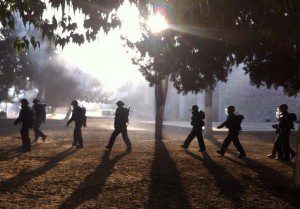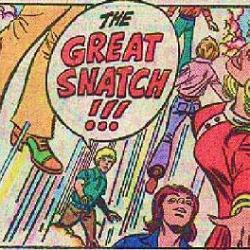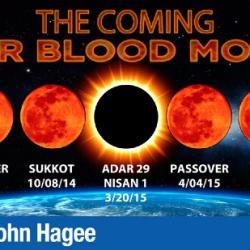In the first Left Behind novel, written in 1995, we’re told that peace and prosperity will come suddenly in the Middle East before the Rapture — which could happen at any moment, possibly even before you finish reading this …
… sentence. OK, it didn’t happen just then, but it could have. Any day, at any time, in the twinkling of an eye, Jesus could come back to get us before we die. (Well, not us, of course. But the real, true Christians.) The Rapture is imminent. No man knoweth the day or the hour but, back in 1995, Tim LaHaye assured us that the day and the hour weren’t far off at all.
But before the Rapture comes — at any moment — something else apparently has to happen first. Israel has to make peace with all of its neighbors (and vice versa). Writing in 1995, Tim LaHaye and Jerry Jenkins assumed this would happen quickly and easily. Back in 2003, I doubted that. Today, in 2014, I still doubt that.
Left Behind, pp. 8-9
Here in reality, the “road map” peace plan is stumbling and staggering and likely to fall apart. Israeli Prime Minister Ariel Sharon and Palestinian leader Yasser Arafat seem determined to undermine the plan in any way possible. Its two-state solution, and its stated goal of an independent Palestinian state in what is now the occupied West Bank by the year 2005, seems highly optimistic.
Tim LaHaye and Jerry Jenkins don’t believe in the road map peace plan. They have their own idea of what is necessary to end the perpetual conflict in the region. The problem, they say, is that Israel simply is not yet wealthy enough. Increase Israel’s GDP, they argue, and peace will bloom like a magically fertile desert.
L&J like to drop startling, audacious plot points with little fanfare. It’s a tendency that can give the reader whiplash. For instance:
The prosperity brought about by the miracle formula changed the course of history for Israel. Flush with cash and resources, Israel made peace with her neighbors. Free trade and liberal passage allowed all who loved the nation to have access to it. What they did not have access …
Wait — did you catch that second sentence? L&J fly by this remarkable development offhandedly, but it seems that in the fantastic world of Left Behind there is a firmly established peace in the Middle East.
Never had Israel enjoyed such tranquility. The walled city of Jerusalem was only a symbol now, welcoming everyone who embraced peace.
Even the thorniest question of the Middle East peace process — the status of Jerusalem — has been easily and breezily dealt with. The entirety of Jerusalem is simply accounted as a part of Israel, but everyone else is permitted to freely come and go within it. And no one in the region has any qualms about this tidy arrangement.

How neat. How convenient, how simple and, like so much else in Left Behind, how utterly out of sync with anything resembling reality.
How this remarkable tranquility actually came about — how decades and generations of violence, hatred and mutual mistrust were swept away — L&J don’t say. They, again, don’t even seem to be interested. And it doesn’t occur to them that their readers might be interested in or curious about such a startling development.
In the real world, or in an even semi-realistic fictional world, any hint of progress toward peace in the Middle East is the stuff of Nobel prizes and banner headlines. The path toward peace is marked with the graves of brave men — Sadat, Rabin — assassinated for their willingness to pursue anything other than continuing conflict. Yet L&J see no dramatic potential in exploring such a story. They simply present a miracle formula which in turn brings about a formulaic miracle: agricultural bounty = wealth = peace and an end to all animosity.
L&J believe that “biblical prophecy” foretells the establishment of a peaceful and prosperous Greater Israel — one which includes not only the entirety of the West Bank, but everything from the Mediterranean to the freaking Euphrates. Israel, according to this strange prophecy, is like a Red Giant. It is destined to swell as it dies, swallowing up Jordan, Syria and a sizeable chunk of Iraq before ultimately going supernova at Armageddon and collapsing forever into a black hole. (L&J would not approve of this metaphor — they consider the life cycle of stars a fiction of corrupt, secular humanist evolutionary theory.)
Now, try to conceive of any possible course of events that would — in the space of a few short months or years — take us from the world we live in today to a world in which the state of Israel has expanded to such a vast extent while simultaneously making fast friends with the Palestinians and the rest of the Arab world.
Can you imagine any way this might happen? L&J couldn’t either. That’s why, as they often do when conveying something ridiculously implausible, they simply assert it matter-of-factly in the hopes that the reader won’t pay too much attention.
L&J sincerely believe that we are now living in the End Times. They wrote Left Behind in the hopes of convincing others that this is so.
Yet on page after page the reader is confronted with jarring illustrations of how glaringly, insurmountably incompatible this End Times world is with the actual world we are living in. The more you read, the more this book undermines the argument that our world and the world of the End Times are the same thing.
If you accept L&J’s belief that Left Behind accurately portrays the world of the End Times as they believe it to be, then, by their own standard, you must conclude that the End is a long, long, looooong way away from here.
















